The Papaya plant is a short-lived herbaceous plant that grows in almost every part of the earth. To maintain a constant supply of fruits, it is important to provide an adequate amount of fertilizer from time to time. Proper nutrition is essential for Papaya to produce high yields and quality fruits. Regular application of balanced, all-purpose fertilizer with Papaya helps in the proper growth of Papaya tree and fruit development.
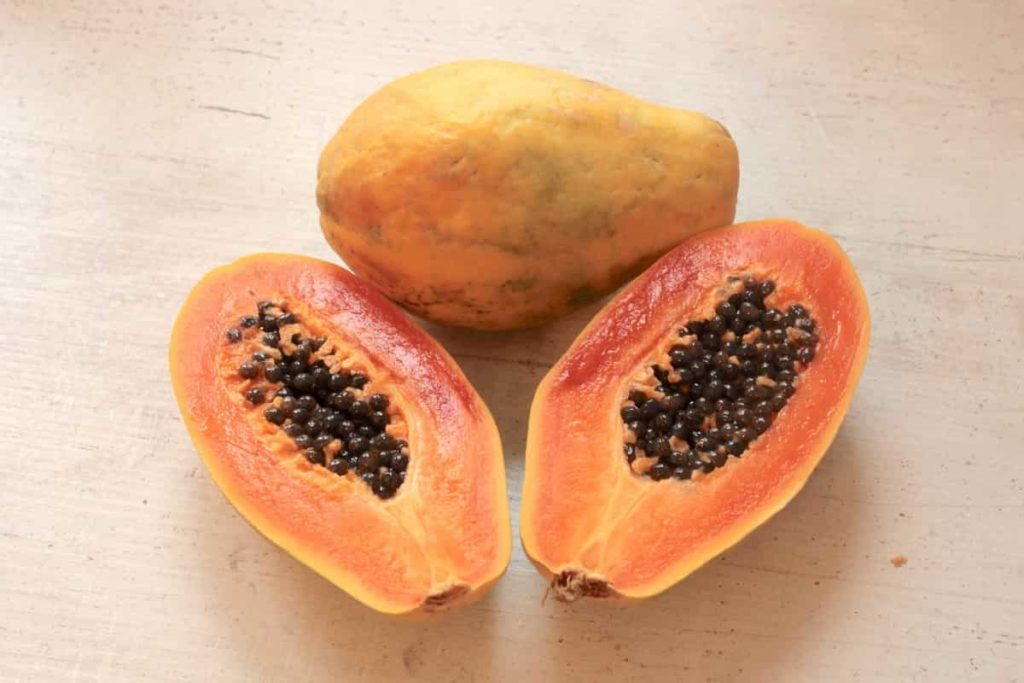
Also, drip irrigation can be used to apply fertilizer and is known as fertigation. Applying water and soluble nutrients to growing plants through fertilization is an effective way to maximize yields with greater nutrition and water use efficiency. Let’s check out the best fertilizers for Papaya trees.
Inorganic fertilizers for Papaya trees
Papaya is a fast-growing plant that produces flowers and fruits all year round. That is why it is important to provide regular nutrition. It is generally recommended to use 200 grams each of N, P, K with 25 kg FYM for maximum yield. Inorganic fertilizers should be given in 5 divided doses in 2, 4, 6, 8, and 10 months after planting. However, the fertilizer dose should be adjusted based on soil analysis. Nitrogen and potash in the form of ammonium sulphate and sulphate of potash, respectively, improve fruit quality and color. Fertilizer should be placed in a 10 cm deep trench at a distance of 15-20 cm from the stem and covered with soil.
Inorganic fertilizers (top dressing) (a) Nitrogen-200 grams, (b) Phosphorus-200, (c) Potassium 200 grams per plant per year. Micronutrient mixture 120 gms, Ecohume granules 200 gms, Calcium nitrate 250 gms, Manganese sulphate 200 gms, and Magnesium sulphate 200 gms. NPK can be supplied in divided doses every 60 days. Other nutrients can be supplemented in equal doses three times a year. Borax soil should be used 15 to 20 grams per plant per month to maintain the health of flowers for good fruit.
In case you miss this: High Density Papaya Plantation – Spacing, Yield In India
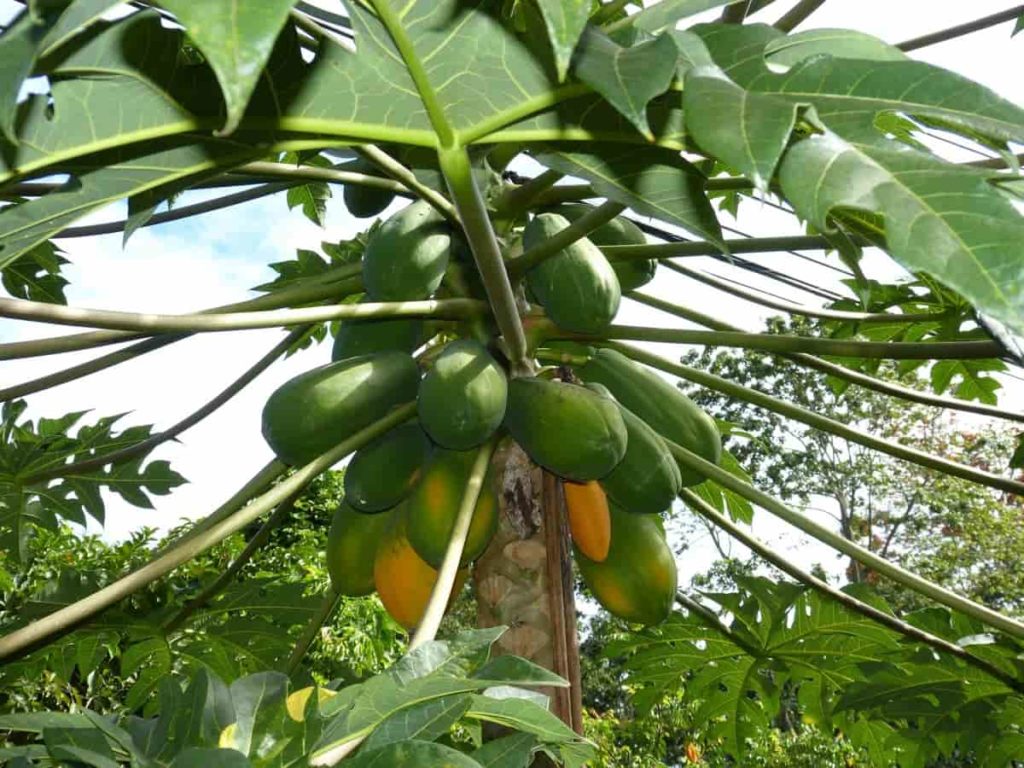
This application is made in split doses to avoid nutrient loss due to volatilization and leaching. Excessive use of nitrogen, which is a common practice among farmers, should be avoided as it promotes plant growth and leads to fruit spoilage. The use of ammoniacal nitrogen on Papaya plants does not reduce fruit set but also increases the chances of viral infections such as Papaya-colored spot viruses and other viral infections.
Organic fertilizers for Papaya trees
Organic fertilizer for Papaya can be used regularly to provide these nutritional needs and to promote the growth and strength of your plants.
- The Papaya plant needs a large number of manures and fertilizers. In addition to basic food, fertilizers are also needed.
- Nutrition should be applied based on soil testing values and recommendations for specific agro-ecological regions.
- Papaya plants are planted in pits of 60 x 60 x 60 cm size.
- Pits are dug about a fortnight before planting in summer.
- Pits are filled with 20 kg of topsoil along with 20 Kg. of farmyard manure., 1 Kg of neem cake, and 1 kg bone meal.
- Application of 200-gram N / pit is best for fruit production, but with an increase in N to 300 g / pit, papain yield increases.
Bio-organic fertilizer for Papaya
Bio-organic fertilizer for Papaya is very useful for keeping Papaya fruit plants healthy and improving their yield. Aside from the fact that it is safe for your family, fertilizers will not harm the environment as they are biodegradable. This type of fertilizer does not pollute the soil and water as compared to synthetic fertilizer. As it is all-natural, it also enriches the soil with the nutrients that plants need to stay healthy. Another good thing about fertilizer use is that it helps restore damaged or unhealthy soil and can also improve the quality of the soil on your lawn.
In case you miss this: Organic Papaya Farming – Cultivation, Production In India
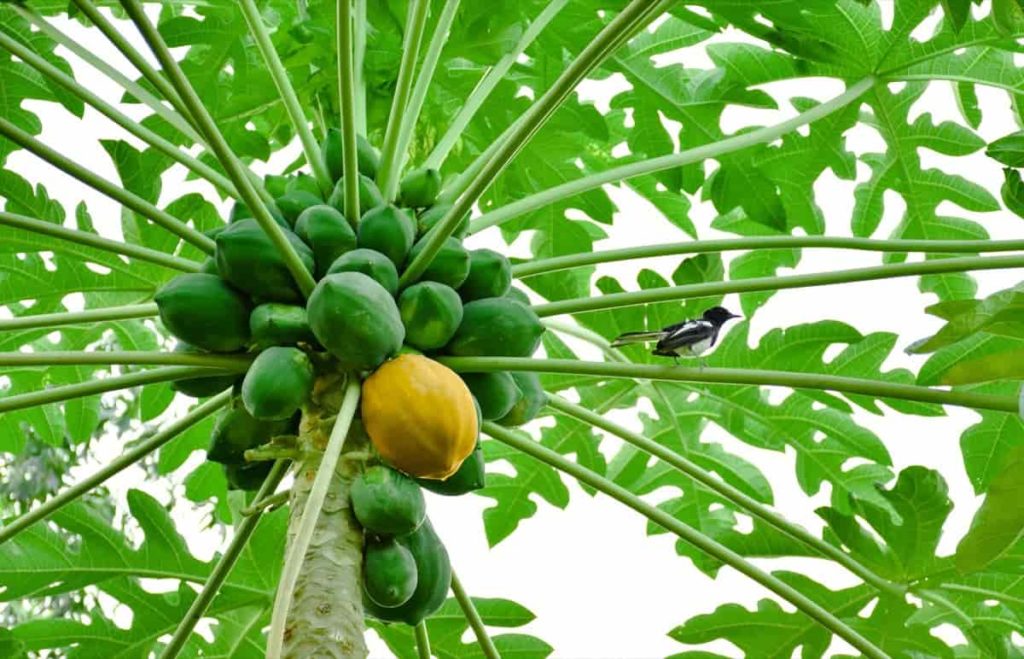
Boost your Papaya yield by applying fertilizers to Papaya trees
Papaya trees are relatively low maintenance, but that does not mean that they do not need proper fertilizers for rapid growth and optimal fruit growth. Newly planted Papayas require phosphorus for proper root formation and development. Therefore, it is a good idea to fertilize the Papaya tree before planting. Proper and effective fertilization of young and mature Papaya trees is essential for maintaining the health of Papaya and achieving high yields. This is a heavy feeder. The range of different nutrients extracted from the soil at different stages of growth by the whole Papaya plant, such as seedling, vegetative, before flowering, flowering, fruit growth, and harvesting. Significant amounts of nutrients are observed after flowering.
Treble Superphosphate
Newly planted Papaya trees need phosphorus for proper root formation and growth. Add 1 pound of treble superphosphate to the planting hole when planting the Papaya tree. Firstly, use the speed to dig a hole about 3 feet wide and 8 inches deep. Then, put superphosphate under the hole before planting the Papaya tree.
14-14-14 Fertilizer
Balanced, regular use of fertilizer with all-purpose fertilizer helps in proper growth of Papaya tree and fruit development. For best results, use 14-14-14 products starting in the third month after planting. Use 4 ounces 14-14-14 per Papaya tree, once every four weeks. Then, in the six months after planting, increase it to 6 ounces of 14-14-14 every five weeks. Always water your Papaya tree immediately after fertilization, as it helps carry nutrients to the roots of the Papaya tree and reduces the risk of burning nitrogen.
In case you miss this: Papaya Pests and Diseases, Control Management
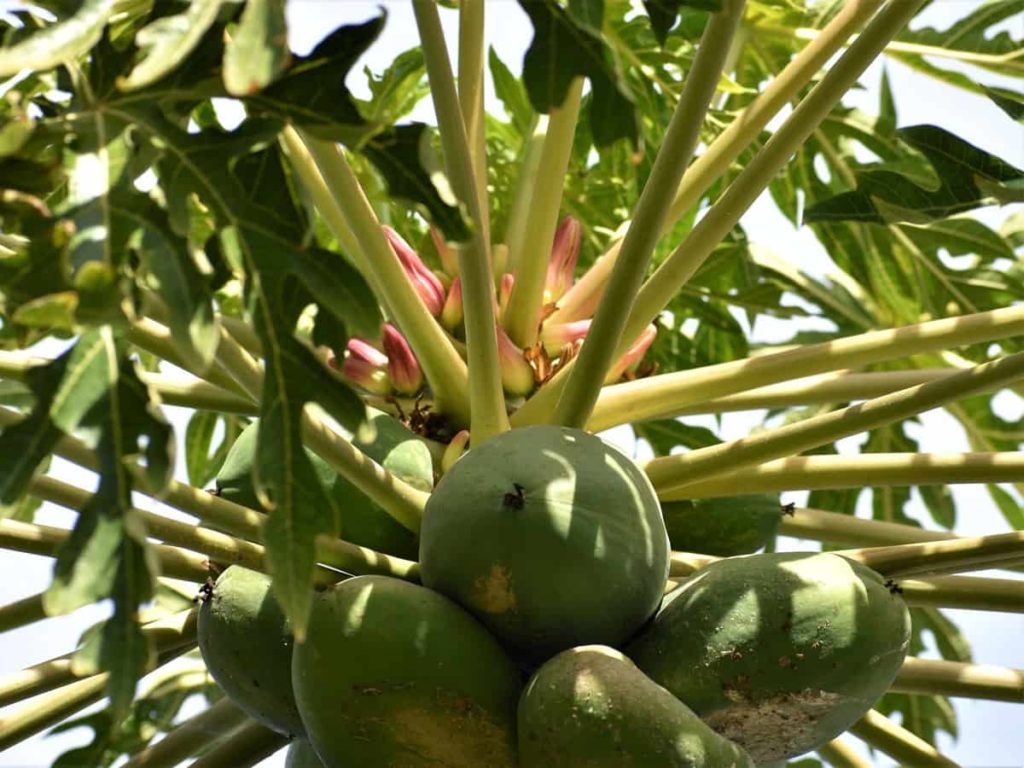
The Papaya crop is a very heavy feeder. The following nutrients are required per plant fruit season.
- FYM – 10 kg
- Neem cake – 1 kg
- Urea – 600 gm
- SSP – 1400 gm
- MOP – 700 gm
The inorganic fertilizers should be given in six split doses (once in two months) during the vegetative growth and flowering stage. For better fruit growth spray 1 or 2 ZnSO4 @ 5 grams per liter of water and Borax @ 1 gram per liter of water during vegetative growth and flowering.
In case you miss this: Papaya Flower and Fruit Drop, Causes, Control Methods
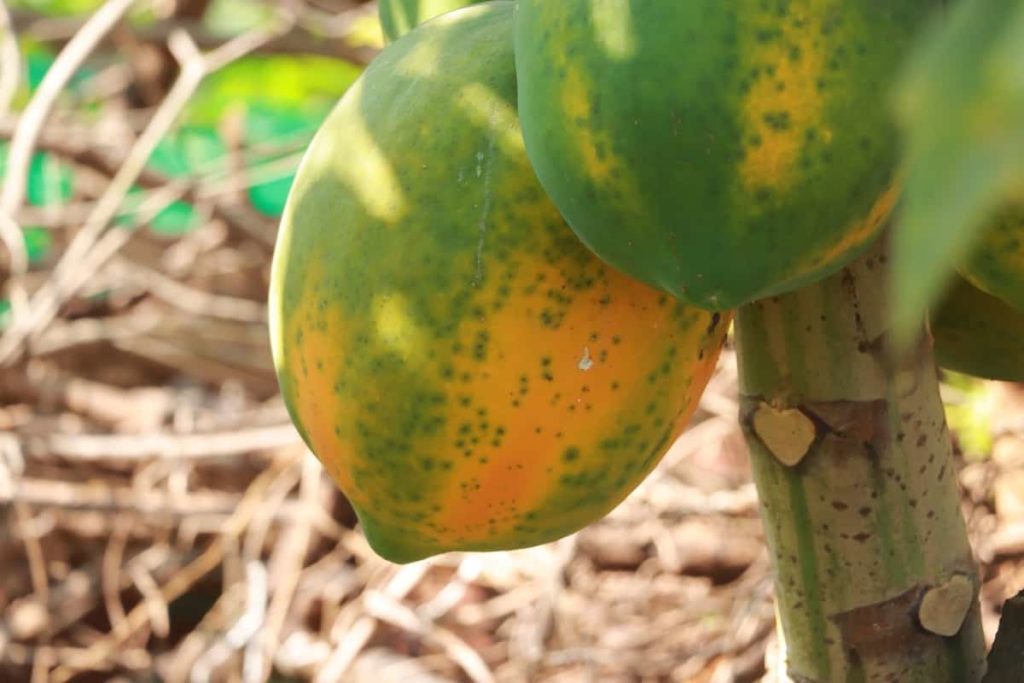
When to fertilize Papaya trees
Papaya needs to be fertilized regularly, as the size of the plant increases.
Planting seed
To grow Papaya from seed, remove seeds from ripe fruits, wash them in a colander to remove the gel-like covering. Using the nutrients stored in the seeds, the seeds germinate in two to three weeks. After germination, the plants require additional fertilizer. Apply to incorporate slow-release fertilizer like 14-14-14. The use of strong fertilizers or soluble fertilizers in planting holes can burn plant roots. Alternatively, fertilize plants every 10 to 14 days by mixing half-strength all-purpose soluble fertilizers such as 10-10-10 at the rate of 1/2 teaspoon per gallon of water.
Planting young Papaya
For purchased Papaya plants or seedlings that you have planted yourself that are about 6 to 12 inches tall and about 0.5 ounces of balanced controlled fertilizer such as 14-14-14 in the planting hole, mix it well with backfill soil and water the plant. Young Papayas should be careful when transplanting Papaya, as they are susceptible to root damage or rootball disturbances. Choose a place in full sun and choose the least possible place to experience the cold.
Fertilizing younger plants
Fertilize younger plants more frequently with small amounts of complete, balanced fertilizers such as 14-14-14. Apply 1/4 pound every 14 days, water it well.
Fertilizing the established plants
Once the plants are seven to eight months old, every other month apply 1 to 2 pounds of Papaya 14-14-14 fertilizer per plant with a balanced fertilizer, passing it through the drip line to the top layer of soil. Work and then water the trees well. If growth slows down in the cold season of autumn and winter, reduce the amount of fertilizer. Papayas prefer dry soil in cold weather, so fertilizer can be used to carry it deeper into the soil without watering or rain.
In case you miss this: Papaya Seed Germination, Period, Temperature, Process
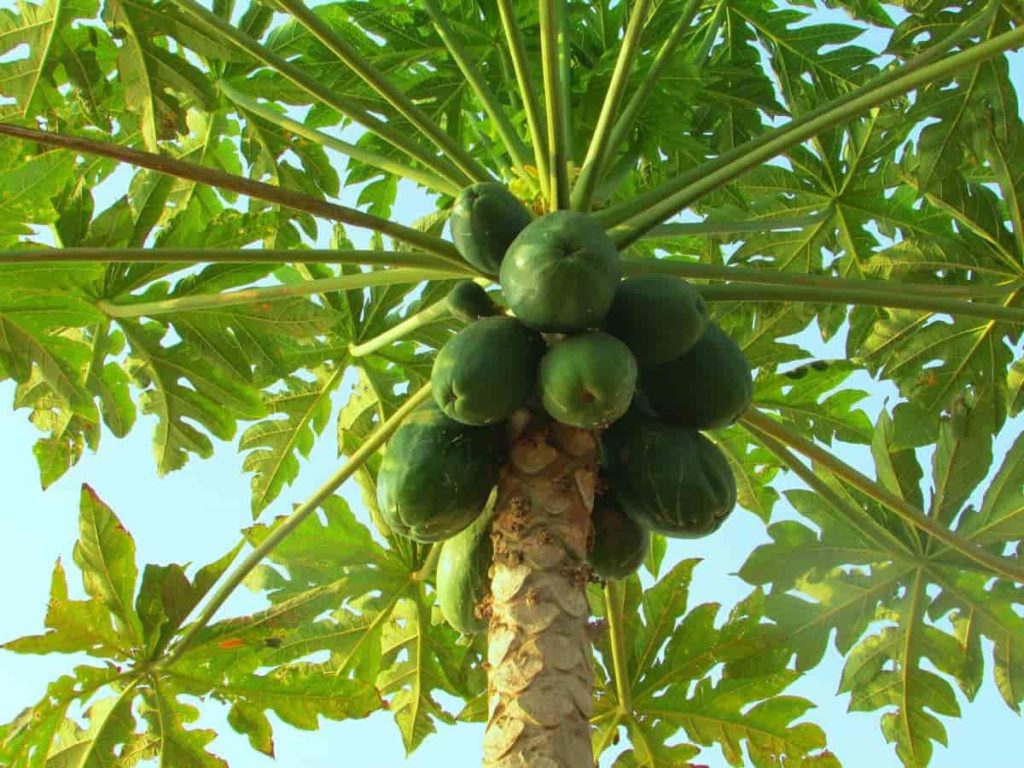
Integrated nutrition management for Papaya trees
Papaya should be fertilized once every two months. Although the use of fertilizer in a particular area depends on soil and leaf analysis, 90 grams of urea, 250 grams of superphosphate, and 140 grams of muriate of potash are generally recommended for each plant. The total requirement is 250 g N + 250 g P2O5 + 500 g K2O per plant/year.
In addition to fertilizer, it is recommended to apply 7-10 kg farmyard manure/plant every six months. The technique of leaf analysis for Papaya has also been standardized and the recently matured 11th leaf petiole is the best. Fertigation can also be done with soluble fertilizers which save about 25-30% of fertilizer. Apply 100% recommended N and K fertilizers with drip irrigation (50 g N and 50 g K2O) as well as 50 g P2O5 at two-month intervals.
- How to Make Houseplants Bushy: Effective Tips and Ideas
- Innovative Strategies for Boosting Coconut Pollination and Yield
- Pollination Strategies for Maximum Pumpkin Yield
- The Complete Guide to Chicken Fattening: Strategies for Maximum Growth
- Natural Solutions for Tulip Problems: 100% Effective Remedies for Leaf and Bulb-Related Issues
- Revolutionizing Citrus Preservation: Towards a Healthier, Greener Future
- Natural Solutions for Peony Leaf and Flower Problems: 100% Effective Remedies
- Maximizing Profits with Avocado Contract Farming in India: A Comprehensive Guide
- Natural Solutions for Hydrangea Problems: 100% Effective Remedies for Leaf and Flowers
- The Ultimate Guide to Choosing the Perfect Foliage Friend: Bringing Life Indoors
- From Sunlight to Sustainability: 15 Ways to Use Solar Technology in Agriculture
- The Ultimate Guide to Dong Tao Chicken: Exploring from History to Raising
- The Eco-Friendly Makeover: How to Convert Your Unused Swimming Pool into a Fish Pond
- Mastering the Art of Delaware Chicken Farming: Essentials for Healthy Backyard Flocks
- 20 Best Homemade Fertilizers for Money Plant: DIY Recipes and Application Methods
- How to Craft a Comprehensive Free-Range Chicken Farming Business Plan
- Brighten Your Flock: Raising Easter Egger Chickens for Beauty and Bounty
- How to Optimize Your Poultry Egg Farm Business Plan with These Strategies
- Subsidy for Spirulina Cultivation: How Indian Government Schemes Encouraging Spirulina Farmers
- Ultimate Guide to Raising Dominique Chickens: Breeding, Feeding, Egg-Production, and Care
- Mastering the Art of Raising Jersey Giant Chickens: Care, Feeding, and More
- Ultimate Guide to Raising Legbar Chickens: Breeding, Farming Practices, Diet, Egg-Production
- How to Raise Welsummer Chickens: A Comprehensive Guide for Beginners
- How to Protect Indoor Plants in Winter: A Comprehensive Guide
- Ultimate Guide to Grow Bag Gardening: Tips, Tricks, and Planting Ideas for Urban Gardeners
- Guide to Lotus Cultivation: How to Propagate, Plant, Grow, Care, Cost, and Profit
- Agriculture Drone Subsidy Scheme: Government Kisan Subsidy, License, and How to Apply Online
- Ultimate Guide to Raising Araucana Chickens: Breed Profile, Farming Economics, Diet, and Care
- Bringing Hydroponics to Classroom: Importance, Benefits of Learning for School Students
- Ultimate Guide to Raising Polish Chickens: Breed Profile, Farming Economics, Diet, and Care
- Ultimate Guide to Raising Australorp Chickens: Profile, Farming Economics, Egg Production, Diet, and Care
- Silkie Chicken Farming: Raising Practices, Varieties, Egg Production, Diet, and Care
- Sussex Chicken Farming: Raising Practices, Varieties, Egg Production, Diet and Care
- Homemade Feed Formulations for Livestock: Discover Cost-effective Starter to Finisher Feed Recipes
- 20 Best Pig Weight Gain Supplements: Top Swine Weight Gain Formulas
- Ultimate Guide to Elderberry Farming: Propagation, Planting, Yield, Cost, and Profit
Very insightful agricultural information